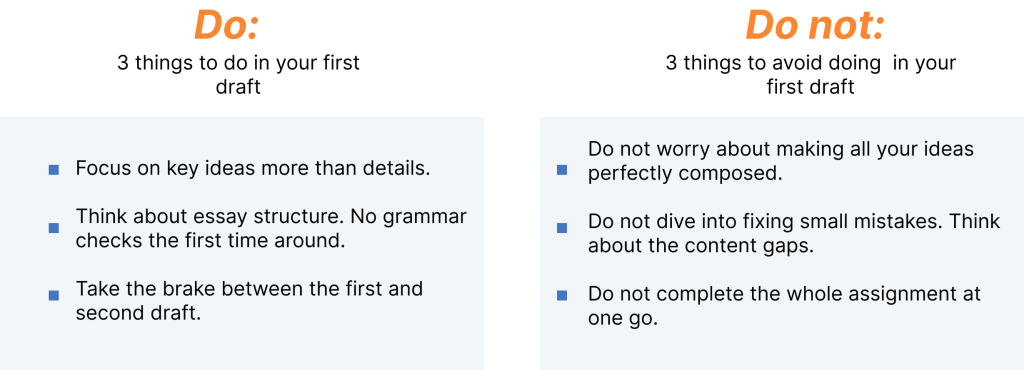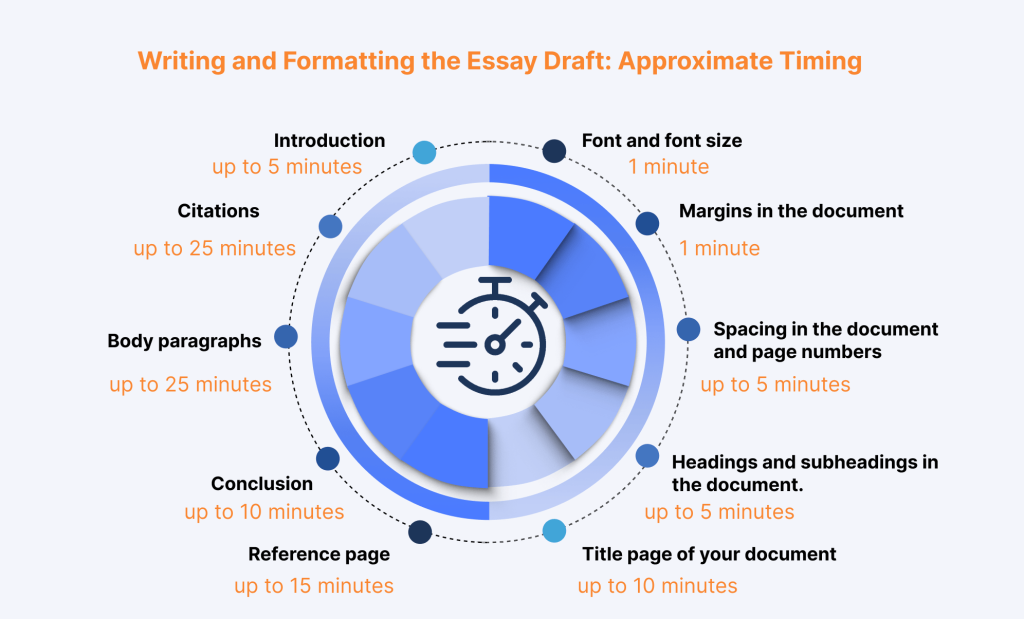Draft writing is an essential component of the essay composition process, where your thoughts and ideas begin to take shape. This post provides a draft example that illustrates the early stage of professional academic essay writing. In this professional masterclass, we’ll also dive deeper into this crucial stage of how to right a essay, providing you with valuable insights and practical guidance on how to create a compelling essay draft example that serves as the foundation for your final essay.
How to Prepare for Draft Writing?
What is a draft in writing? Successfully writing the draft of your essay relies on preparedness. Here’s a bit more information on how to prepare for the written drafting process:
- Choose your topic wisely
Choose a topic that you are interested in and fits the assignment’s guidelines. The drafting phase becomes more enjoyable and productive when people write about an appropriate topic.
- Research extensively
To write the first draft of the essay, dip into your chosen subject and source widely respectable materials. Please, note that you would need to reference them when writing.
- Plan your work
Formulate a well-thought-out outline of your essay. Write your thesis statement and develop your major claims. Drafting is easier if there is a rough roadmap.
- Set realistic goals
Do you think of time management? It is crucial. Please consider the amount of time that you are able to upload this paper. It makes the process less stressful by setting the reason for your targets.
Writing a draft is essential as it saves you a lot of time and effort. If you try to make things perfect while writing from scratch, you risk ending up with procrastination, writer’s block, and failed deadlines. Writing a draft, instead, gives you a solid ground to stand on in your later writing steps.
Next, we move towards the core of the first draft of the essay. Let’s see what is important to write in your draft.
An Example of Draft Essay Crafted By an Expert
To gain the most crucial insights into the drafting process, we’ll explore a first draft example, showcasing the raw form of an essay. Here’s my rough draft essay example:
Title: Effect of climate change on global biodiversity
Introduction
Climate change is a serious problem of worldwide influence. This paper investigates the complex connection between climate change and its consequences on the world’s biological variety. There exists substantial evidence of this fact—warming of global temperatures, more frequent extreme weather phenomena and changed precipitation cycles—these are all direct consequences of climate change.
Main body 1: The Changing Climate
But climate change is not a theory; it is happening now. With rising global temperatures, many glaciers are melting and the sea level is rising. Thereby, they cause problems for ecosystems and species worldwide. For example, the loss of Arctic sea ice destroys the natural home of polar bears, almost making them go extinct.
Main body 2: Biodiversity in Peril
The global ecosystem has been overwhelmed. Deforestation and habitat destruction are also causing rainforests to disappear, the home of countless species. Iconic species like the Amazon rainforest jaguar struggle to adapt, and numerous others face a similar predicament.
Main body 3: Human Impact
It is impossible to deny that human activities have contributed to intensified climate change. This situation worsens due to the emission of greenhouse gasses from the burning of fossil fuels and deforestation. It is important to recognize that we are part of this equation, and we need to address the consequences accordingly.
Conclusion
Climate change and its effects on the global biosphere warrant an immediate response. We need to tackle this with utmost dedication and enthusiasm, for it is bound to affect our future as a nation. Hence, action calls for developing meaningful tools for combating an impending biodiversity crisis and raising awareness worldwide.
In this short example of draft essay, we’ve touched upon the critical components of an essay: an interesting start, a clear structure of the main body, and powerful final paragraphs.
For those working on research papers, it’s beneficial to review a rough draft example for research paper to see how ideas progress and evolve. Drafting requires practice, revisions, and commitment.
What should be included in your first draft: Tips
What should be included in your first draft? As you embark on your draft writing journey, keep these tips in mind to create a robust and effective first draft:
- Stay true to your outline. Your outline is your guiding structure. Stick to it to ensure your essay remains organized and on track.
- Don’t worry about perfection. The first draft is not the time for perfection. Focus on getting your ideas down on paper.
- Embrace revision. Understand that revisions are a natural part of the writing process. Your first draft is not your final product.
- Cite as you go. Properly cite your sources within the draft, saving you time when it comes to creating your reference list.
- Seek feedback. Share your draft with peers or instructors for constructive feedback. Another set of eyes can provide valuable insights.
- Edit for clarity. While you don’t need to perfect grammar and sentence structure in the first draft, ensure your ideas are clear and easily comprehensible.
- Stay on topic. Regularly review your outline to ensure you’re staying on the topic and addressing your thesis statement.

How to Write a Draft: What to Include?
What should an essay look like? Here’s more information on the key elements you should include in your draft of the essay to ensure it’s comprehensive and well-structured:
- Introduction
The first step is an insightful introduction. The opening paragraph should consist of an attention-catching introduction with a thesis statement.
- Body
The next step is body paragraphs crafting. Thesis must have well-organized sections containing a topic sentence, supportive evidence, and linking phrases in order to create logical and coherent arguments.
- Conclusion
The final step is your conclusion. Please consider that you should make a clear conclusion by wrapping up your major arguments and reaffirming your thesis statement for lasting impact.
- Citations
Make sure you cite your sources accurately by citing them correctly in-text using an acceptable referencing style such as APA, MLA, or Chicago.
- References
Drafting with this in mind will ensure that you don’t forget the information sources that form the basis of the list. The end results make it easier to cite.
- In-text citations
You should insert references within your text body according to the rules of APA citation guidelines in order to maintain the consistency and authenticity of your paper.
- Clear structure
The content should develop a good flow by presenting the ideas sequentially in an orderly manner. If you are hesitant about this, you can email your instructor.
So, this is how to write a draft!
Formatting the essay draft
Formatting is a critical aspect of draft writing. Here’s more information on ensuring your draft adheres to formatting guidelines:
- Font and font size of your document. Use a legible font and font size appropriate for your formatting and writing style, such as Times New Roman or Arial at 12pt.
- Margins in the document. Set the margins to the appropriate size, which is usually 1 inch on both sides.
- Spacing in the document. Maintain the appropriate line spacing, such as double-spaced or 1.5-spaced, according to the requirements.
- Headings and subheadings in the document. Use appropriate headings and subheadings to organize your information while adhering to the formatting style guidelines.
- Page numbers in the document. Insert page numbers according to your formatting style, usually in the header or footer.
- Title page of your document. If your essay requires one, make sure it includes all of the relevant information in the proper manner.

Let’s examine some problems concerning the first stage and propose an idea on how to overcome them.
What Is a First Draft Challenge?
Writing the first draft cannot be an easy path. What is a first draft main problem you may face? Here’s information on common challenges and how to overcome them:
- Writer’s block. It cannot be easy, but the trick is to keep writing, even if it means scribbling down poor phrases. You can always go back and revise afterward.
- Grammar and sentence structure. Don’t sweat it throughout the initial draft. Concentrate on writing down your ideas first; refining comes afterward.
- Lack of clarity. It’s natural for your initial draft of the essay to be a little disjointed. As you write again, make sure your thoughts are more cohesive.
- Concerns about word count. Don’t worry too much about word count at first. Concentrate on communicating your ideas; the length may be adjusted during the editing stage.
- Staying on topic. Continue to examine your outline before submitting it to verify you’re on track and not deviating into unrelated tangents.
To overcome these issues, try employing the following tools, which can help to speed up the drafting process.
How to write a rough draft essay with tools?
Now, let’s explore some tools that can aid in the editing and formatting process. Using appropriate tools, writing an essay quickly has become easier and much less difficult. You can quickly learn how to write a rough draft essay using them. Here’s information about the tools offered by CustomWritings that can assist in various aspects of draft writing:
Plagiarism Checker
The CustomWritings plagiarism checker is a key tool for authenticating your content. This plagiarism detection software ensures that the paper is original by conducting a check against internet sources to identify possible matches.
Citation Generator
CustomWritings’ Citation Generator formats your sources in a different citation style, such as APA, MLA, and Chicago. This will guarantee that your references use the correct formatting and writing style.
Thesis Statement Generator
Creating a strong thesis statement is crucial for a successful essay. CustomWritings’ Thesis Statement Generator can assist you in crafting a clear and concise thesis statement that forms the backbone of your essay.
Words to Minutes Converter
If your draft includes a speech or presentation, CustomWritings’ Words to Minutes Converter is a useful tool. Enter the word count to determine how long it will take to deliver your content, helping you manage your presentation time effectively.
Words to Pages Converter
Knowing precisely how many pages your work will run based on per-word computation means it is easy to arrange the page properly. By using the Words to Pages Converter of CustomWritings, you will be able to estimate the number of pages after entering the required word count and format.
AI Essay Writer
Dealing with writer’s block or seeking inspiration? CustomWritings’ AI Essay Writer provides a unique essay generated by AI, offering fresh ideas and sources to help you overcome writing obstacles.
Reference Finder
Finding reliable sources is a crucial part of academic writing. CustomWritings’ Reference Finder can help you discover relevant articles, books, and research projects for your topic, saving you valuable research time.
AI Detector
To ensure the authenticity of your work, CustomWritings’ AI Detector can check if any part of your text was AI-generated, ensuring the content is genuinely yours.
These tools can significantly ease the drafting process and ensure that your draft adheres to academic guidelines and integrity.
Draft writing is a journey of discovery and refinement, an art that improves with practice and dedication. This professional masterclass covers essential techniques on how to write a draft essay, providing you with the skills to create well-structured and compelling academic papers. To understand the principles of effective essay composition, we’ll analyze a draft essay example. You may provide a solid basis for your final essay by preparing properly, using useful resources, and following formatting requirements. Ideas take shape in the initial draft, and edits bring them to perfection. Accept this process, solicit input, and realize that excellence requires work. Good luck with your writing!
